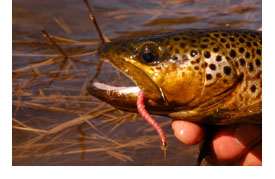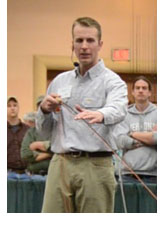
There are no absolutes in fly fishing and that’s why I refer to this approach as a theory. While this “theory” produces good results, there will be times you will have to adjust your way of thinking as there are no absolutes in fly fishing. What I’m referring to is trying to get inside the mind of a wintertime feeding trout. Think about it, wintertime is a period when these cold blooded critter’s feeding habits slow down as water temperatures drop. In many river systems, trout begin to drop back into the slower moving bodies of water in an effort to expend less energy. Although their metabolisms may slow down, feeding is still on their mind and the wintertime can be the right time for the angler to venture out to the river. Often the most popular sections are void of anglers and I’ve had several days where the action would rival a May sulphur hatch. A wintertime feeding trout may not always mirror its springtime foraging behavior, but trout still need to eat and a larger presentation may be the ticket. Sometimes all trout need is a little encouragement so I often call upon larger patterns to create that desire.
By larger, I’m referring to nymph patterns as large as #4 and small as a #10. Yes that big-even on spring and limestone streams. Think about this, trout feel sluggish and less motivated to continuously chase small food items down during these cold winter months. Instead, it seems logical that trout would be willing to spend less energy chasing down larger food items. Move less and obtain more calories! Large stonefly, caddis, egg and worm patterns are my usual wintertime suspects. Nymphing is normally my first choice as I can slowly present the flies. Streamer tactics also work well but only when trout are feeling up to the chase. The idea is to present a pattern that can fulfill a trout’s hunger with only one energy surge. In many ways, this relates to human wintertime eating behaviors.
During the warmer months I find myself constantly snacking throughout the day-mostly due to my high level of physical activity (Fishing, playing with my kids, my daily workout regiment and so on). However, I snack far less during the colder winter months as I expend less physical energy (less daylight=less playtime). This theory also plays out well for me when targeting trout during extreme cold weather conditions. Trout may indeed feed less during the winter but I believe they become more opportunistic foragers. Many of the live bait fishers I stay in contact with have their greatest results fishing larger baits (sculpins, night crawlers, and live crayfish) in the slower moving waters during the winter months.
The moral of the story is you still need to be dynamic-change when necessary but don’t be afraid to present larger than average patterns during the wintertime. I think you will be pleasantly surprised with the results.

George Daniel has served as assistant manager at TCO Fly Shop, in State College, PA. He travels the country conducting fly-fishing clinics for various groups and organizations. George has been associated with Fly Fishing Team USA. Some of his accomplishments include being a two-time national fly fishing champion, winning The Fly Fishing Masters, and ranked as high as fifth in the World along with other competitive achievements. George is the author of two books about nymph and streamer fishing. He lives near Lamar, Pennsylvania. If you want to keep up with George in the Internet you can follow him on his Facebook page here.
Last edited:



